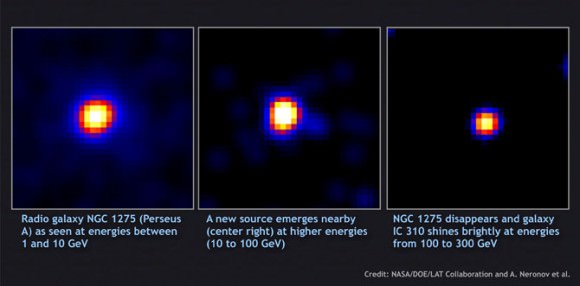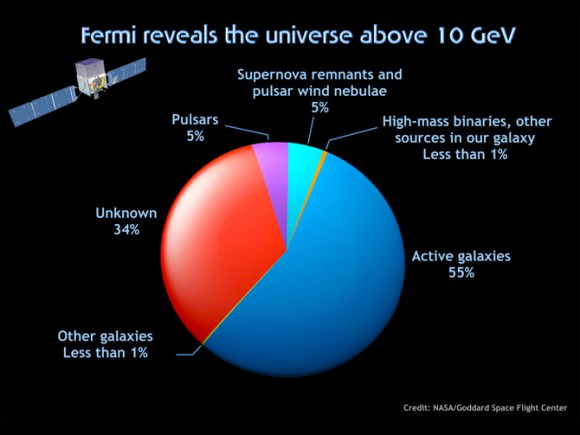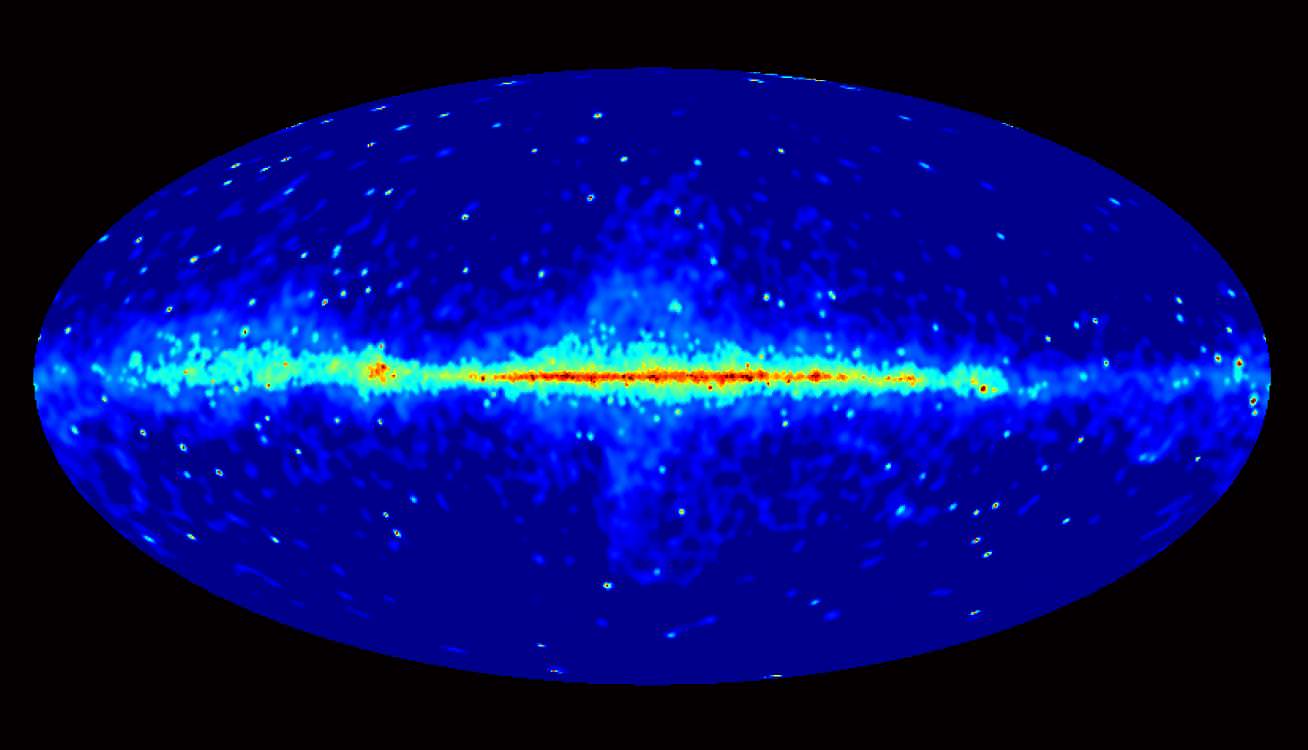[/caption]
It scans the entire visible sky every three hours. Its job is to gather light – but not just any light. What’s visible to our eyes averages about 2 and 3 electron volts, but NASA’s Fermi Gamma-Ray Space Telescope is taking a deep look into a higher realm… the electromagnetic range. Here the energy doesn’t need a boost. It slams out gamma-rays with energies ranging from 20 million to more than 300 billion electron volts (GeV). After three years of space time, the Fermi Large Area Telescope (LAT) has produced its first census of these extreme energy sources.
Over its current operating time, Fermi has continued to paint an ever-deepening portrait of the gamma-ray sky. Even with the huge amount of data which pours in over its 180 minute window, high energy events are not common. When it comes to sources above 10 GeV, even Fermi’s LAT detects only one source about three times a year.
“Before Fermi, we knew of only four discrete sources above 10 GeV, all of them pulsars,” said David Thompson, an astrophysicist at NASA’s Goddard Space Flight Center in Greenbelt, Md. “With the LAT, we’ve found hundreds, and we’re showing for the first time just how diverse the sky is at these high energies.”
Just what exactly is out there which can produce such a powerful process? When it comes to gamma-rays, more than half of Fermi’s nearly 500 findings are active galaxies where matter falling into their central supermassive black holes produces intense jets spewing out at close to light speed. A small portion – around 10% – of the census belongs to sources within the Milky Way. These are pulsars, supernova debris and a handful of binary systems which house massive stars. What’s really interesting is the portion of totally unidentifiable sources that constitute about a third of the findings. They simply don’t have any spectroscopic counterparts and astronomers are hoping that these higher energy sources will give them new material to compare their findings against.

When it comes to light – obey the rules. Just as we understand that sources of infra-red light fade away when viewed in the ultra-violet, gamma-ray sources above 1 GeV can disappear without a trace when viewed at higher, or “harder,” energies. “One example is the well-known radio galaxy NGC 1275, which is a bright, isolated source below 10 GeV.” says the Fermi team. ” At higher energies it fades appreciably and another nearby source begins to appear. Above 100 GeV, NGC 1275 becomes undetectable by Fermi, while the new source, the radio galaxy IC 310, shines brightly.” The Fermi hard-source list is the product of an international team led by Pascal Fortin at the Ecole Polytechnique’s Laboratoire Leprince-Ringuet in Palaiseau, France, and David Paneque at the Max Planck Institute for Physics in Munich.

The new Fermi census will be a unique source of comparative information to assist ground-based facilities called Atmospheric Cherenkov Telescopes. These sources have confirmed 130 gamma-ray sources with energies above 100 GeV. They include the Major Atmospheric Gamma Imaging Cherenkov telescope (MAGIC) on La Palma in the Canary Islands, the Very Energetic Radiation Imaging Telescope Array System (VERITAS) in Arizona, and the High Energy Stereoscopic System (H.E.S.S.) in Namibia.
“Our catalog will have a significant impact on ground-based facilities’ work by pointing them to the most likely places to find gamma-ray sources emitting above 100 GeV,” Paneque said.
But big ground-based telescopes have big limitations. In this case, their field of view is very constricted and they can’t operate during daylight hours, full Moon or bad weather. But don’t count them out.
“As Fermi’s exposure constantly improves our view of hard sources, ground-based telescopes are becoming more sensitive to lower-energy gamma rays, allowing us to bridge these two energy regimes,” Fortin added.
Original Story Source: NASA Fermi News Release. For Further Reading: Major Atmospheric Gamma Imaging Cherenkov telescope (MAGIC) on La Palma in the Canary Islands, Very Energetic Radiation Imaging Telescope Array System (VERITAS) in Arizona and High Energy Stereoscopic System (H.E.S.S.) in Namibia. For Further Images: Fermi Images.

